You can build the most beautiful, smooth, and branded landing page ever. And, you can have an incredible website with the most intuitive, easy-to-use user interface. But, here's the thing. You're not going to convert everyone. In fact, you're only going to convert a tiny percentage of the people that visit your site.
Friday, June 28, 2019
Thursday, June 27, 2019
How To Build A Standardised Sales Process
This is a transcript of the talk at the HubSpot User Group (The London HUG) meeting in April 2019 by Brian Sexton a Principal Channel Account Manager at HubSpot in Dublin.
Tuesday, June 18, 2019
What Type of Links Does Google Really Prefer?
email marketing automation tools
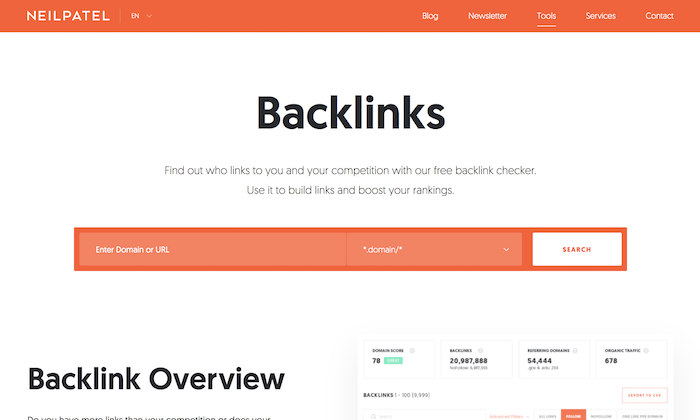
We all know that links help rankings. And the more links you build the higher you’ll rank.
But does it really work that way?
Well, the short answer is links do help with rankings and I have the data to prove it.
But, you already know that.
The real question is what kind of links do you need to boost your rankings?
Is it rich anchor text links? Is it sitewide links? Or what happens when the same site links to you multiple times? Or when a site links to you and then decides to remove the link?
Well, I decided to test all of this out and then some.
Over the last 10 months, I decided to run an experiment with your help. The experiment took a bit longer than we wanted, but we all know link building isn’t easy, so the experiment took 6 months longer than was planned.
Roughly 10 months ago, I emailed a portion of my list and asked if they wanted to participate in a link building experiment.
The response was overwhelming… 3,919 people responded, but of course, it would be a bit too hard to build links to 3,919 sites.
And when I say build, I’m talking about manual outreach, leveraging relationships… in essence, doing hard work that wouldn’t break Google’s guidelines.
Now out of the 3,919 people who responded, we created a set of requirements to help us narrow down the number of sites to something more manageable:
- Low domain score – we wanted to run an experiment on sites with low domain scores. If a site had a domain score of greater than 20, we removed it. When a site has too much authority, they naturally rank for terms and it is harder to see the impact that a few links can have. (If you want to know your domain score you can put in your website URL here.)
- Low backlink count – similar to the one above, we wanted to see what happens with sites with little to no backlinks. So, if a site had more than 20 backlinks, it was also removed from the experiment.
- No subdomains – we wanted sites that weren’t a Tumblr.com or a WordPress.com site or subdomain. To be in this experiment, you had to have your own domain.
- English only sites – Google in English is more competitive than Google in Spanish, or Portuguese or many other languages. For that reason, we only selected sites that had their main market as the United States and the site had to be in English. This way, if something worked in the United States, we knew it would work in other countries as they tend to be less competitive.
We decided to cap the experiment to 200 sites. But eventually, many of the sites dropped off due to their busy schedule or they didn’t want to put in the work required. And as people dropped off, we replaced them with other sites who wanted to participate.
How the experiment worked
Similar to the on-page SEO experiment that we ran, we had people write content between 1,800 and 2,000 words.
Other than that we didn’t set any requirements. We just wanted there to be a minimum length as that way people naturally include keywords within their content. We did, however, include a maximum length as we didn’t want people to write 10,000-word blog posts as that would skew the data.
Websites had 2 weeks to publish their content. And after 30 days of it being live, we looked up the URLs within Ubersuggest to see how many keywords the article ranked for in the top 100, top 50 and top 10 spots.
Keep in mind that Ubersuggest has 1,459,103,429 keywords in its database from all around the world and in different languages. Most of the keywords have low search volume, such as 10 a month.
We then spent 3 months building links and then waited 2 months after the links were built to see what happened to the rankings.
The URLs were then entered back into the Ubersuggest database to see how many keywords they ranked for.
In addition to that, we performed this experiment in batches, we just didn’t have the manpower and time to do this for 200 sites all at once, hence it took roughly 10 months for this to complete.
We broke the sites down into 10 different groups. That’s 20 sites per group. Each group only leveraged 1 link tactic as we wanted to see how it impacted rankings.
Here’s each group:
- Control – with this group we did nothing but write content. We needed a baseline to compare everything to.
- Anchor text – the links built to the articles in this group contained rich anchor text but were from irrelevant pages. In other words, the link text contained a keyword, but the linking site wasn’t too relevant to the article. We built 3 anchor text links to each article.
- Sitewide links – they say search engines don’t care for sitewide links, especially ones in a footer… I wanted to test this out for myself. We built one sitewide link to each article.
- Content-based links – most links tend to happen within the content and that’s what we built here. We built 3 content-based links to each article.
- Multiple links from the same site – these weren’t sitewide links but imagine one site linking to you multiple times within their content. Does it really help compared to having just 1 link from a site? We built 3 links from the same site to each article.
- One link – in this scenario we built one link from a relevant site.
- Sidebar links – we built 3 links from the sidebar of 3 different sites.
- Nofollow links – does Google really ignore nofollow links? You are about to find out because we built 3 nofollow links to each article.
- High authority link – we built 1 link with a domain score of 70 or higher.
- Built and removed links – we built 3 links to articles in this group and then removed them 30 days after the links were picked up by Google.
Now before I share what we learned, keep in mind that we didn’t build the links to the domain’s homepage. We built the links to the article that was published. That way we could track to see if the links helped.
Control group
Do you really need links to rank your content? Especially if your site has a low domain score?
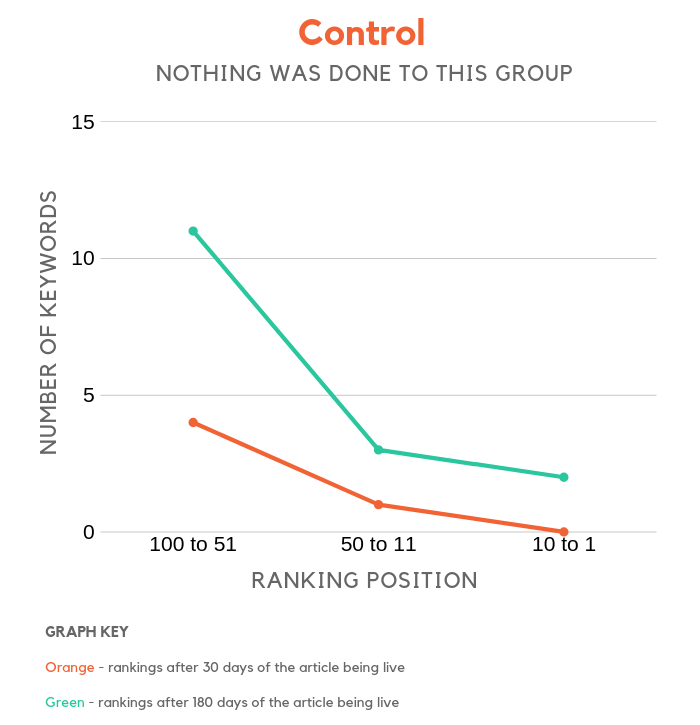
Based on the chart, the older your content gets, the higher you will rank. And based on the data even if you don’t do much, over a period of 6 months you can roughly rank for 5 times more keywords even without link building.
As they say, SEO is a long game and the data shows it… especially if you don’t build any links.
Anchor text
They say anchor text links really help boost rankings. That makes sense because the link text has a keyword.
But what if the anchor rich link comes from an irrelevant site. Does that help boost rankings?
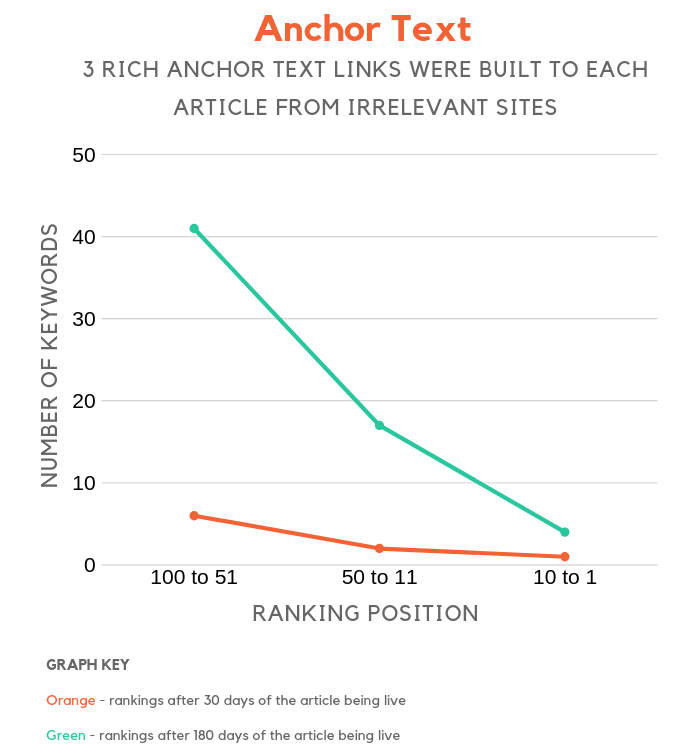
It looks like anchor text plays a huge part in Google’s rankings, even if the linking site isn’t too relevant to your article.
Now, I am not saying you should build spammy links and shove keywords in the link text, more so it’s worth keeping in mind anchor text matters.
So if you already haven’t, go put in your domain here to see who links to you. And look for all of the non-rich anchor text links and email each of those site owners.
Ask them if they will adjust the link and switch it to something that contains a keyword.
This strategy is much more effective when you ask people to switch backlinks that contain your brand name as the anchor text to something that is more keyword rich.
Sitewide Links
They say sitewide links are spammy… especially if they are shoved in the footer of a site.
We built one sitewide footer link to each article to test this out.
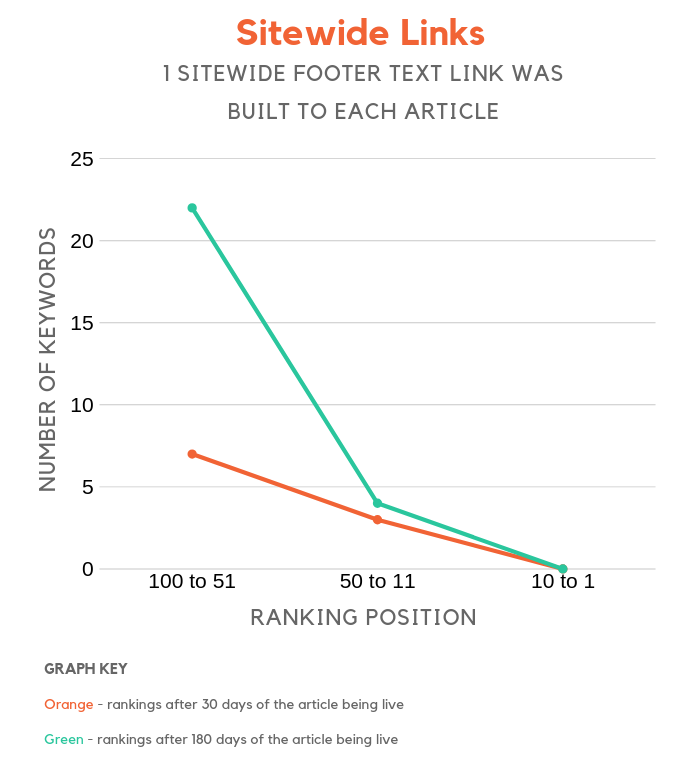
Although sites that leverage sitewide links showed more of an increase than the control group, the results weren’t amazing, especially for page 1 rankings.
Content-based links
Do relevance and the placement of the links impact rankings? We built 3 in-content links that were relevant to each article.
Now the links were not rich in anchor text.
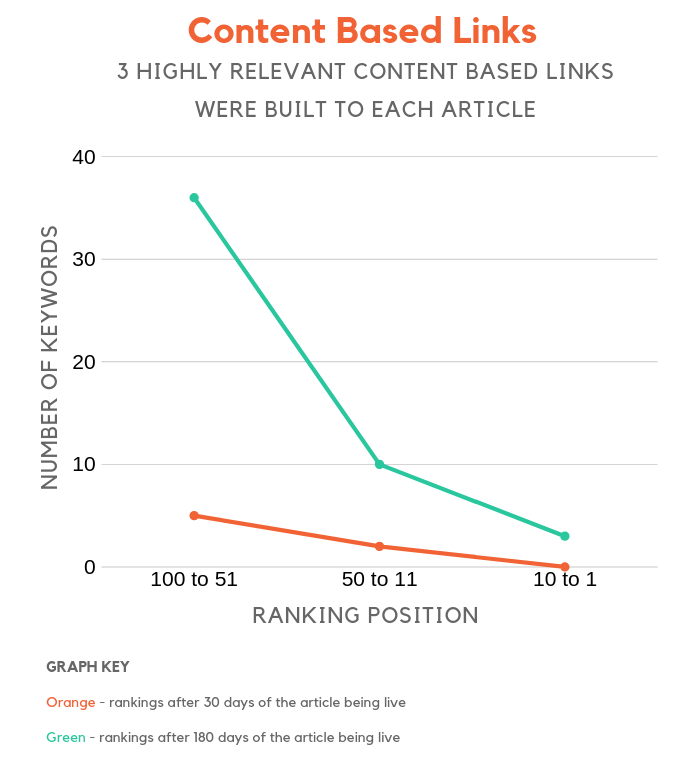
Compared to the baseline, rankings moved up to a similar rate as the sites who built rich anchor text links from irrelevant sites.
Multiple site links
I always hear SEOs telling me that if you build multiple links from the same site, it doesn’t do anything. They say that Google only counts one link.
For that reason, I thought we would put this to the test.
We built 3 links to each article, but we did something a bit different compared to the other groups. Each link came from the same site, although we did leverage 3 different web pages.
For example, if 3 different editors from Forbes link to your article from different web pages on Forbes, in theory, you have picked up 3 links from the same site.
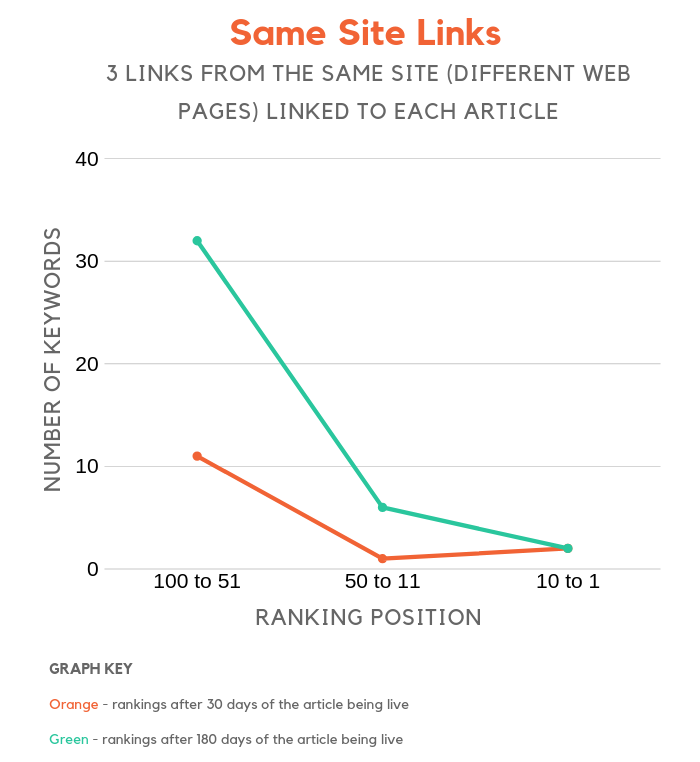
Even if the same site links to you multiple times, it can help boost your rankings.
One link
Is more really better? How does one relevant link compare to 3 irrelevant links?
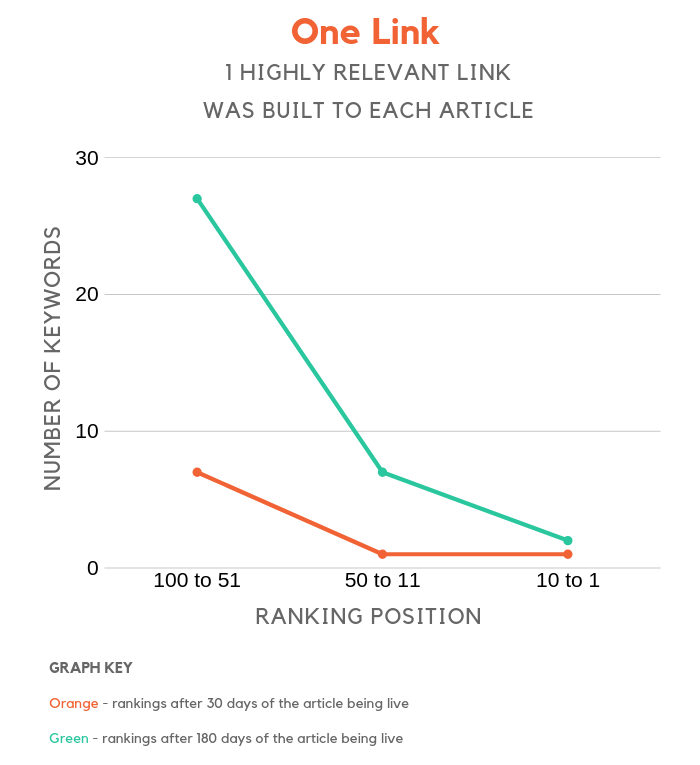
It’s not as effective as building multiple links. Sure, it is better than building no links but the articles that built 3 relevant backlinks instead of 1 had roughly 75% more keyword placements in the top 100 positions of Google.
So if you have a choice when it comes to link building, more is better.
Sidebar links
Similar to how we tested footer links, I was curious to see how much placement of a link impacts rankings.
We looked at in-content links, footer links, and now sidebar links.
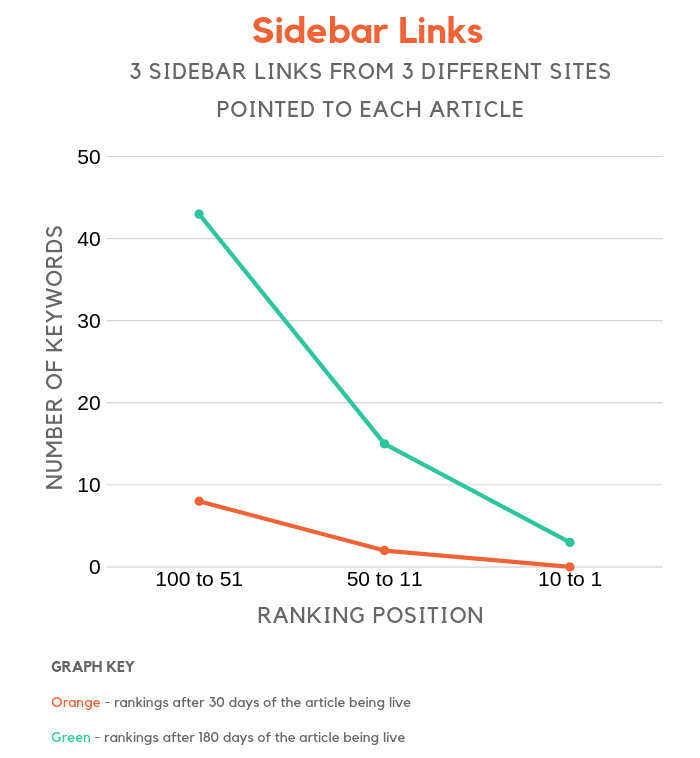
Shockingly, they have a significant impact in rankings. Now in order of effectiveness, in-content links help the most, then sidebar links, and then sitewide footer when it comes to placement.
I wish I tested creating 3 sitewide footer links to each article instead of 1 as that would have given me a more accurate conclusion for what placements Google prefers.
Maybe I will be able to run that next time. 🙁
Nofollow links
Do nofollow links help with rankings?
Is Google pulling our leg when they say they ignore them?
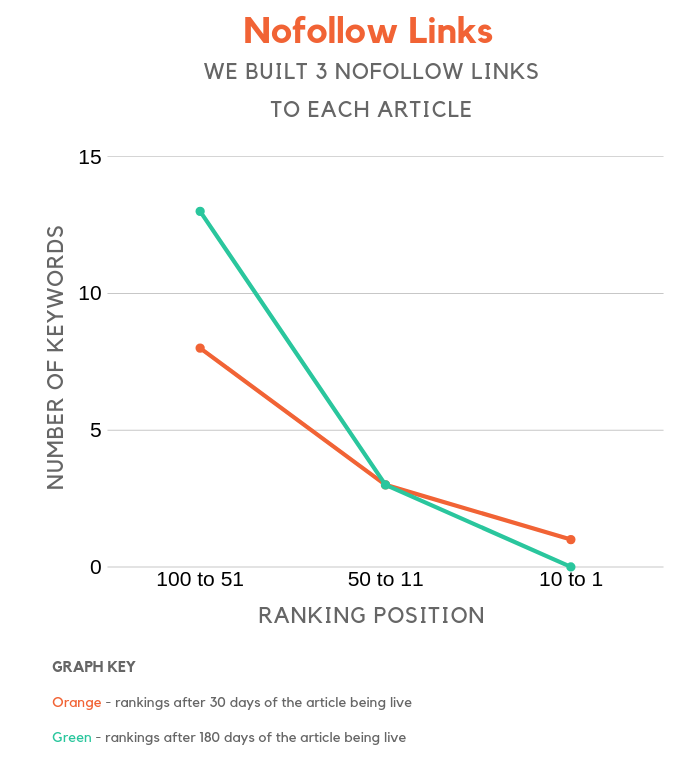
From what it looks like, they tend to not count nofollow links. Based on the chart above, you can see that rankings did improve over time, but so did almost every other chart, including the control group.
But here’s what’s funny: the control group had a bigger percentage gain in keyword rankings even though no links were built.
Now, I am not saying that nofollow links hurt your rankings, instead, I am saying they have no impact.
High authority link
Which one do you think is better:
Having one link from a high domain site (70 or higher)?
OR
Having 3 links from sites with an average or low domain score?
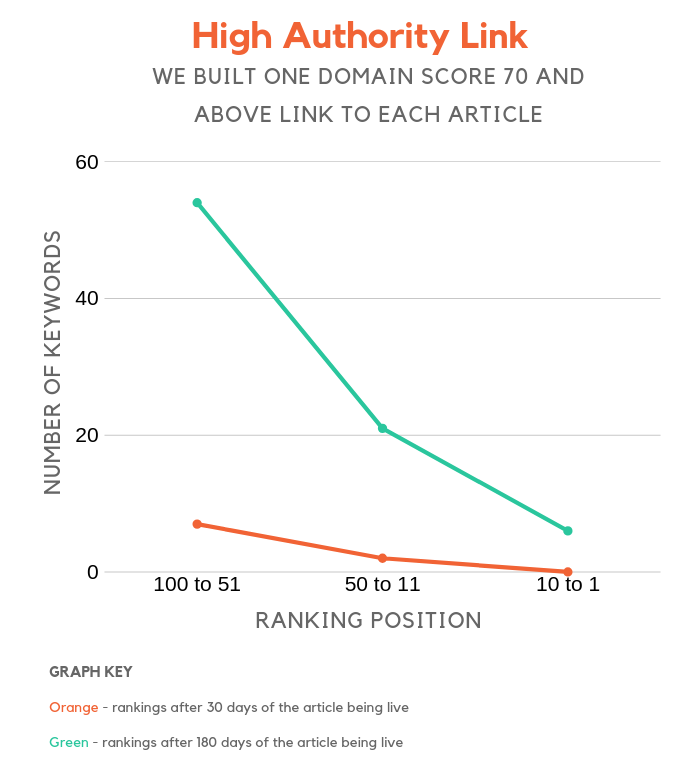
Even though the link from the authority site wasn’t rich in anchor text and we only built 1 per site in this group… it still had a bigger impact than the sites in the other group.
That means high authority links have more weight than irrelevant links that contain rich anchor text or even 3 links from sites with a low domain score.
If you are going to spend time link building, this is where your biggest ROI will be.
Build and removed links
This was the most interesting group, at least that is what the data showed.
I always felt that if you built links and got decent rankings you wouldn’t have to worry too much when you lost links.
After all, Google looks at user signals, right?
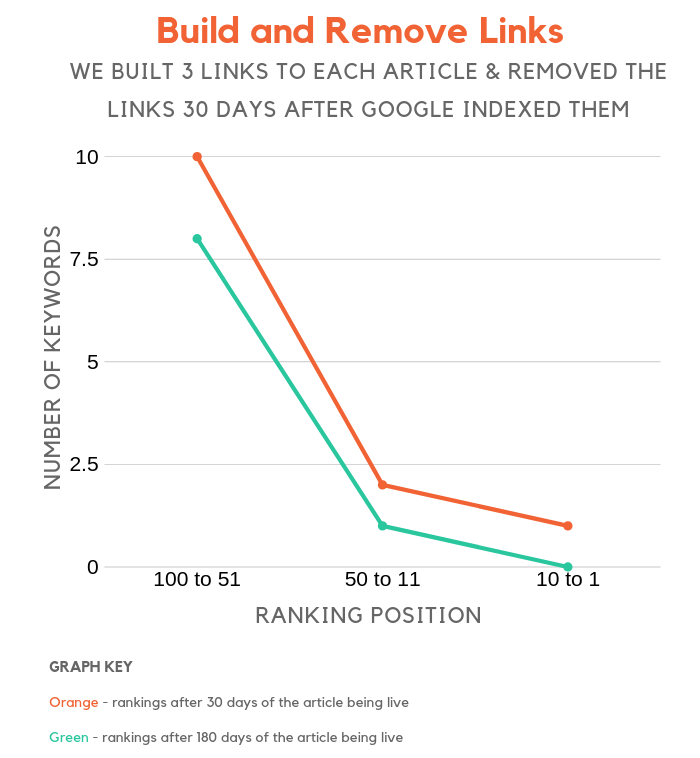
This one was shocking. At least for sites that have a low domain score, if you gain a few links and then lose them fairly quickly, your rankings can tank to lower than what they originally were.
I didn’t expect this one and if I had to guess, maybe Google has something programmed in their algorithm that if a site loses a large portion of their links fast that people don’t find value in the site and that it shouldn’t rank.
Or that the site purchased links and then stopped purchasing the links…
Whatever it may be, you should consider tracking how many links you lose on a regular basis and focus on making sure the net number is increasing each month.
Conclusion
I wish I had put more people behind this experiment as that would have enabled me to increase the number of sites that I included in this experiment.
My overall sample size for each group is a bit too small, which could skew the data. But I do believe it is directionally accurate, in which building links from high domain score sites have the biggest impact.
Then shoot for rich anchor text links that are from relevant sites and are placed within the content.
I wouldn’t have all of your link text rich in anchor text and if you are using white hat link building practices it naturally won’t be and you won’t have to worry much about this.
But if you combine all of that together you should see a bigger impact in your rankings, especially if you are a new site.
So, what do you think about the data? Has it helped you figure out what types of links Google prefers?
Tuesday, June 11, 2019
Ubersuggest 4.0: The Ultimate Content Marketing Tool
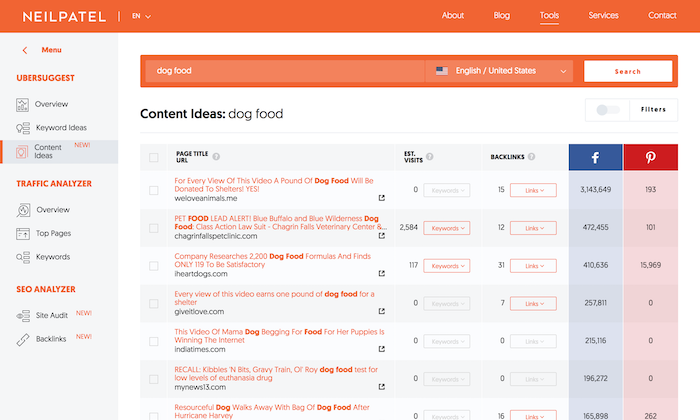
Why do you do keyword research?
It’s to find more lucrative keywords to rank for on Google, right?
But once you find these keywords, you still have to figure out how to rank for them.
For that reason, I decided to update Ubersuggest because I wanted to show you what kind of content to create and even how to promote it.
That way you can start ranking for these newly found keywords.
Here’s what’s new…
Content ideas
The way you rank for a keyword is by creating content around it. I know content isn’t king anymore and that’s because there are over 1 billion blogs on the web. That means Google can be really picky about what they decide to rank.
So now, not only do you need to write amazing content, but you also have to promote it if you want to do well.
To help you with this I created a Content Ideas report in Ubersuggest. So whenever you do keyword research, you’ll see an overview that looks like this:
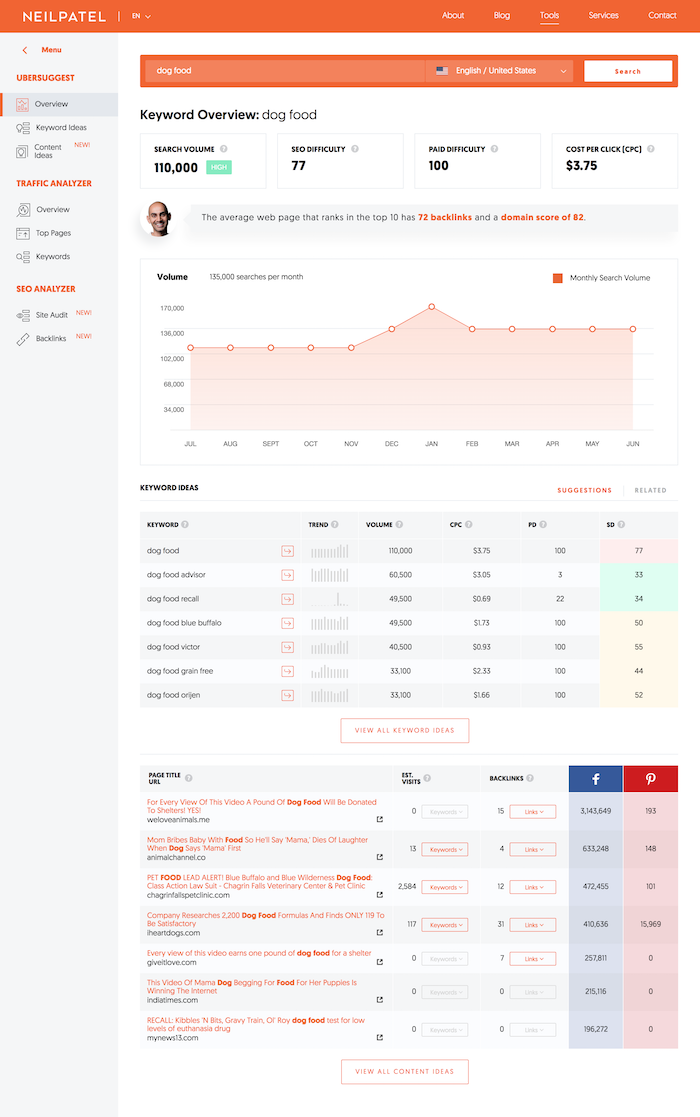
Just like before, you’ll see a graph at the top with the search volume over time, some keyword recommendations and, at the very bottom, a list of blog posts that performed exceptionally well for that keyword.
When you click on “content ideas” in the navigational menu or you click on “view all content ideas,” you’ll then be taken to a page that looks something like this:
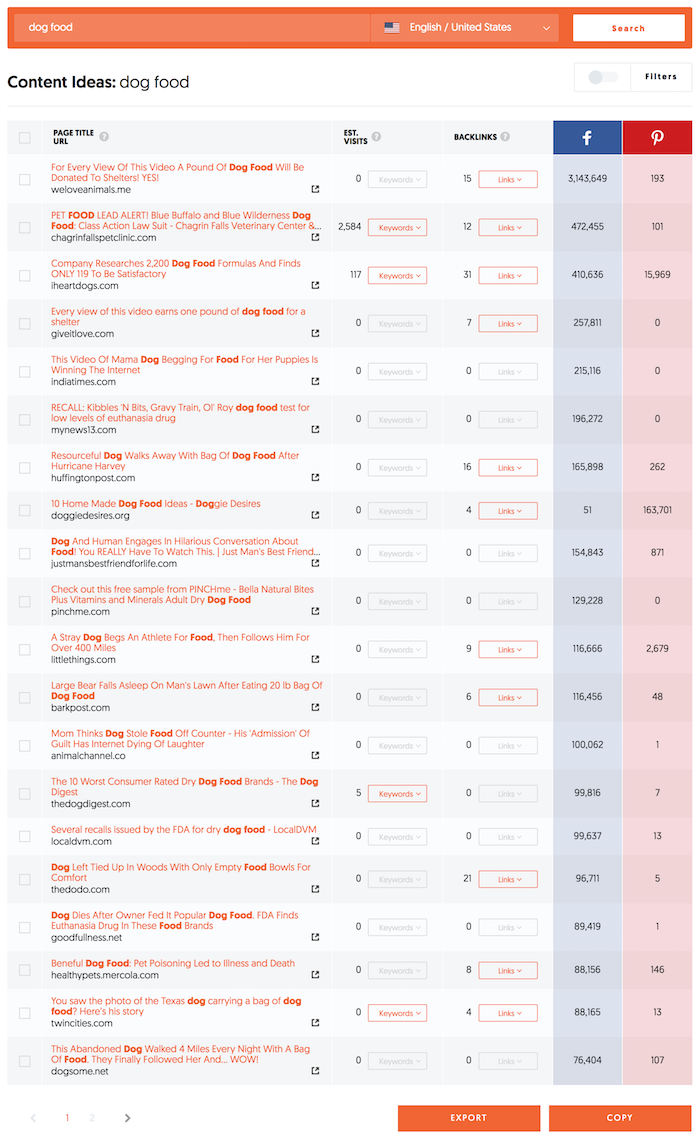
This page shows you all of the popular blog posts that have been written related to the keyword or phrase you searched.
The list is ordered by social shares, so the posts with the highest social shares are at the top. At the bottom, you can keep clicking to see more results. Even if your screen only shows 1 or 2 pages, just keep clicking next and you’ll start to see results for pages 3, 4, 5, etc.
We only show you 20 results per page, but each key phrase will typically have hundreds, if not thousands, of results as our database has over 500,000,000 blog posts from around the world.
And because there are so many results, we’ve also created an easy to use filtering system so you can fine-tune your search by including certain keywords or excluding other ones and even putting minimum and maximum thresholds on social shares.

My favorite part about the content ideas report
I know you can do similar things with Buzzsumo and other tools, but this is why I created the Content Ideas report.
As I mentioned earlier, content isn’t king. You not only have to write amazing content (that’s why I sort the content by social shares as more shares typically mean people love it), but you also have to promote it.
You’ll notice that there are two other columns in this report that make the tool unique… one is “Estimated Visits” and the other is “Backlinks”.

Estimated visits will show you how many visits the blog post generated from Google each month. Just click on “Keywords” and it will even show you the keywords that drive those visits and the position the article ranks for each of those terms.

Backlinks, on the other hand, are all of the referring domains that point to each article. So if 12 unique domains link to that blog post, then you’ll see the number “12” in that column. All you have to do is click on “links” and you’ll see the full list of backlinks.
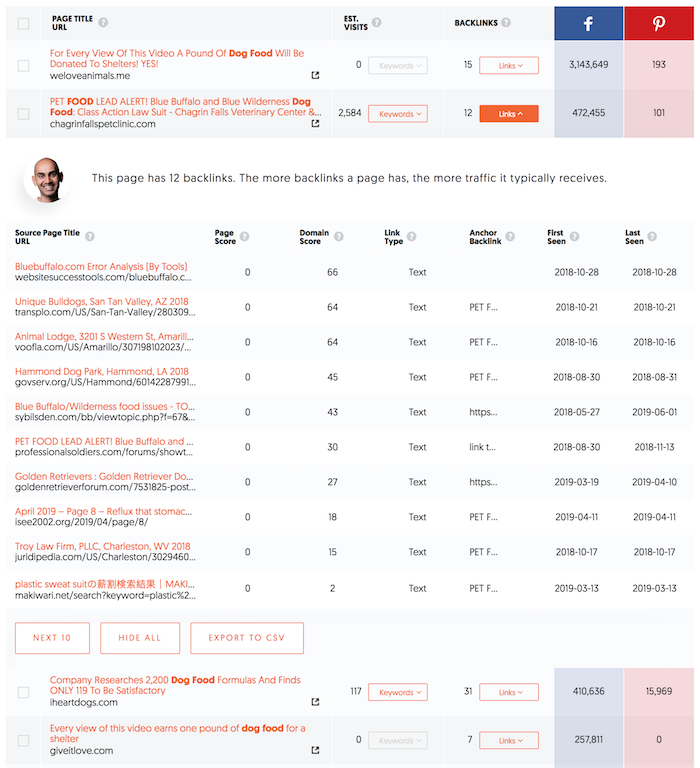
Not only do I provide a thorough list of backlinks, but I also show you the overall page score, domain score, anchor text, and even the type of link.
The reasons I made the Content Ideas report like this are:
- By creating content similar to posts that have a lot of social shares, it increases the chances that the content you are writing is going to do well as people have already shown interest in that topic and even shared it on the social web.
- By showing you the keywords a blog post ranks for, you’ll know what keywords to focus on when writing the content. This way your post can rank as well.
- By showing you who links to your competition, you can now hit up everyone who links to competing articles and ask them to link to your piece of content.
Less fluff and more data
In addition to the Content Ideas report, you’ll now find that Ubersuggest provides you with more data and less fluff when you perform a keyword query.
For example, if you search for the term “dog food,” it will tell you that the average result that ranks in the top 10 has 72 backlinks and a domain score of 82.

This way, if you want to rank for that term or any other term, you’ll have a rough idea of what you need from an authority and backlink standpoint to achieve a spot on page one.
Conclusion
If you are going to create content or write a blog post, you should check out the Content Ideas report each time before you write.
The last thing you want to do is create content that people don’t care about reading. And this report will give you good feedback so that way you aren’t wasting your time creating content that doesn’t generate social shares, backlinks, or rankings.
You’ll also notice that some posts do extremely well from a social sharing standpoint but terrible from a backlink and a search traffic perspective.
Social shares will bring you more short-term traffic and search engines bring you less traffic upfront, but more consistent traffic over time.
This report will help you find a balance so that you can get both short-term traffic and consistent traffic over the long-haul.
So, head on over and try the new Content Ideas report.
What do you think about the content ideas report?
Youtobe
Tuesday, June 4, 2019
3 Formulas We Use to Track Your Marketing ROI
email marketing list providers
Waypost Marketing exists to make our clients successful. We don’t do fancy design award shows. We don’t care about our reputation among other marketing agencies. If we’re not helping your business make more money, that’s the definition of failure in our book.
Youtobe
How to Rank New Content Faster
email marketing affiliate program
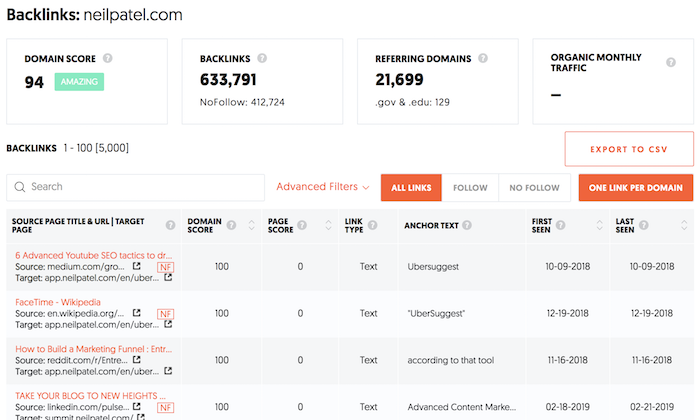
If I write a blog post on any topic, what do you think happens?
It typically gets indexed by Google the same day I publish the content and within a week it tends to rank high on Google.
Then again, I have a domain score of 94 and I have 633,791 backlinks. Just look at the image above. (If you are curious what your link count or domain score is, put in your URL here.)
But if you have a lot fewer backlinks and a much lower domain score, what do you think would happen?
Chances are your content won’t get indexed fast and it won’t rank as high as you want.
But there has to be a way to change this, right? Especially without building more backlinks because we all know that’s time-consuming and hard.
To find the most ideal solution, I decided to run a little experiment.
Around five months ago, I sent out an email to a portion of my mailing list asking people if they wanted to partake in an SEO experiment.
As you could imagine, I had well over a thousand websites who were willing to participate. I had to narrow down the list because for this experiment to be effective, a website had to have a domain score of 30 or less and no more than 40 backlinks.
That way it’s at least a challenge to figure out how to rank new content higher.
In addition to that, the site couldn’t be a subdomain, such as domain.wordpress.com. It had to be a standalone site.
Once I removed all of the outliers, I was left with 983 people who agreed to participate in the experiment. Of those, 347 stopped replying or backed out of the experiment due to time commitments, which means I was left with 636.
How did the SEO experiment work?
For all of the sites, we had them write a piece of content. We didn’t make it a requirement that the content had to be about any specific topic or that it had to be written a certain way… we just had them write one piece of content that was between 1,800 and 2,000 words in length.
We enforced the minimum and maximum length limit because we needed the post to be long enough to naturally include keywords, but if it was too long… such as 10,000 words, it would have a higher chance to rank on Google.
Each site had 30 days to write the piece of content and publish it on their site. Within 30 days of the content being published, we looked up the URL in our Ubersuggest database to see how many keywords the post ranks for in the top 100, top 50, and top 10 spots.
We also repeated this search 60 days after the article was published to see if there were any major differences.
The Ubersuggest database currently contains information on 1,459,103,429 keywords from around the world in all languages (a lot of keywords have low search volume like 10 searches per month). But for this experiment, we focused on English speaking sites.
We then split the sites up into 9 groups. Roughly 70 sites per group. Each group only leveraged 1 tactic to see if it helped with rankings.
Here’s a breakdown of each group.
- Control group – this group just published the article and didn’t leverage any promotional or SEO tactics. Having a control group allows us to compare how specific tactics affect rankings.
- Sitemap – all this group leveraged was a sitemap. They added the article to their sitemap, and we made sure the sitemap was submitted to Google Search Console.
- Internal linking – this group added 3 internal links from older pieces of content to the newly written article.
- URL Inspection – within Google Search Console you can request that they Crawl and index a URL. That feature is called URL Inspection.
- Social shares – Facebook, Twitter, LinkedIn, Pinterest and Reddit were the social sites that this group submitted and promoted their content on.
- Google Chrome lookup – for each site in this group, we had 40 people type in the URL directly into their address bar and look up the site. This could have been done on either mobile or desktop versions of Chrome. I added this group in there because I was curious to see if people visiting your site from Chrome browsers affects your rankings.
- Meta tags – my team optimized the title tag and meta description for everyone in this group. Based on the article, we crafted the optimal meta tags to not only include keywords but also to entice clicks.
- URL – with this group we only optimized their article URL to include keywords and we tried to keep the length around 50 characters as that is what they supposedly prefer.
- Everything – this group combined all of the tactics above other than the control group as they didn’t do anything.
Before I dive into the data, keep in mind that if someone was in one of the groups, we did our best to make sure that they weren’t leveraging any other tactic. For example, for everyone who wasn’t in the sitemap group, we had them remove their existing sitemaps for Google Search Console (other than the everything group).
Control group
So how many keywords does an average website with a domain score of 30 or less rank for in Google within a month and even two months?
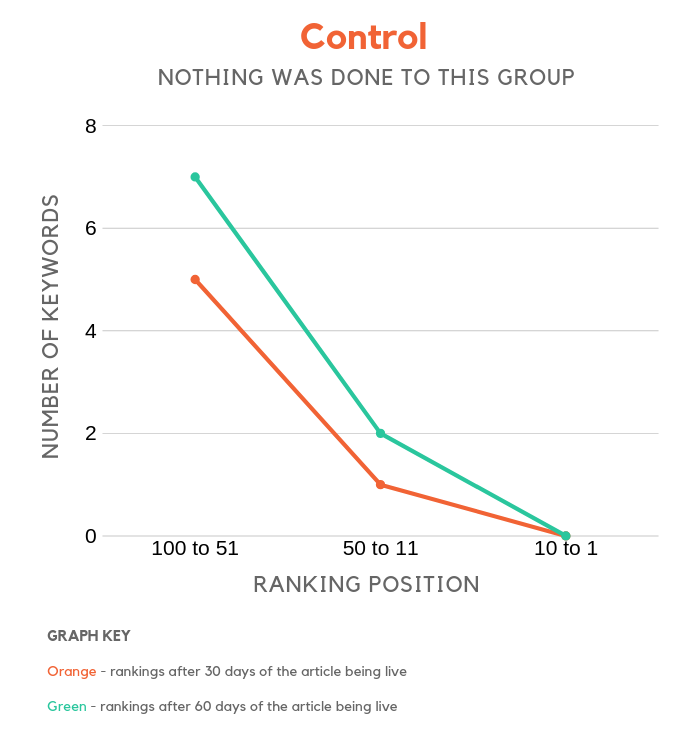
I was shocked at how many keywords a site could rank for when it barely has any links and a low domain score.
But what wasn’t as shocking is how a web page’s ranking can increase over time. The orange line shows the number of keywords that ranked within the first 30 days and the green line shows the number over the first 60 days.
Sitemap group
You know how people say you need an XML sitemap, well it is even more important if you have a low domain score. At least, that is what the data shows.
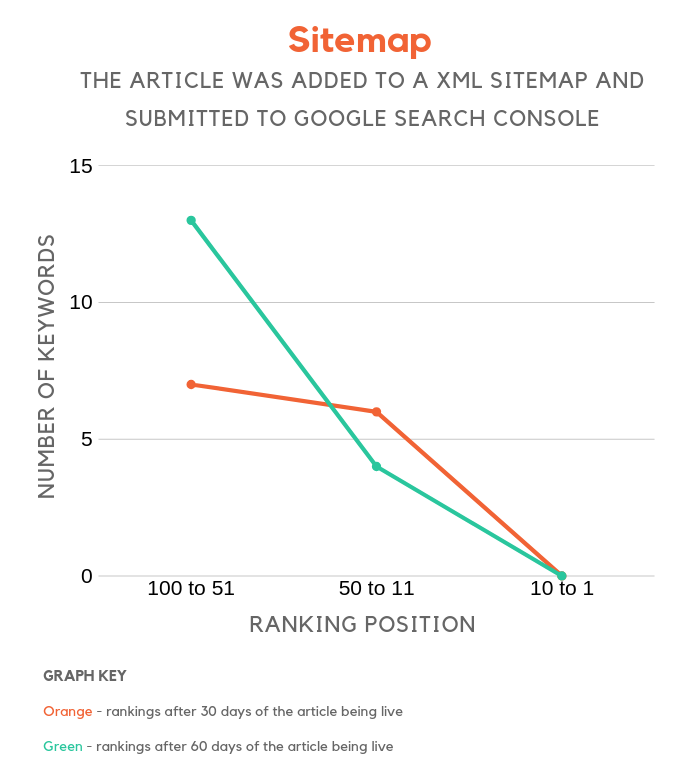
When your site has very few links and a low domain score, you’ll find that Google may not crawl your site as often as you want. But by leveraging a sitemap, you can speed up the indexing process, which helps decrease the time it takes for your site to start ranking for keywords.
Internal linking group
Links, links, and more links… it’s what every site needs to rank well. Technically they are external links, but internal links are better than nothing.
When you add internal links from your old content to your newer articles, it helps them get indexed faster and it helps push them up in the rankings.
Especially when these internal links come from relevant pages that have some decent rankings on Google.
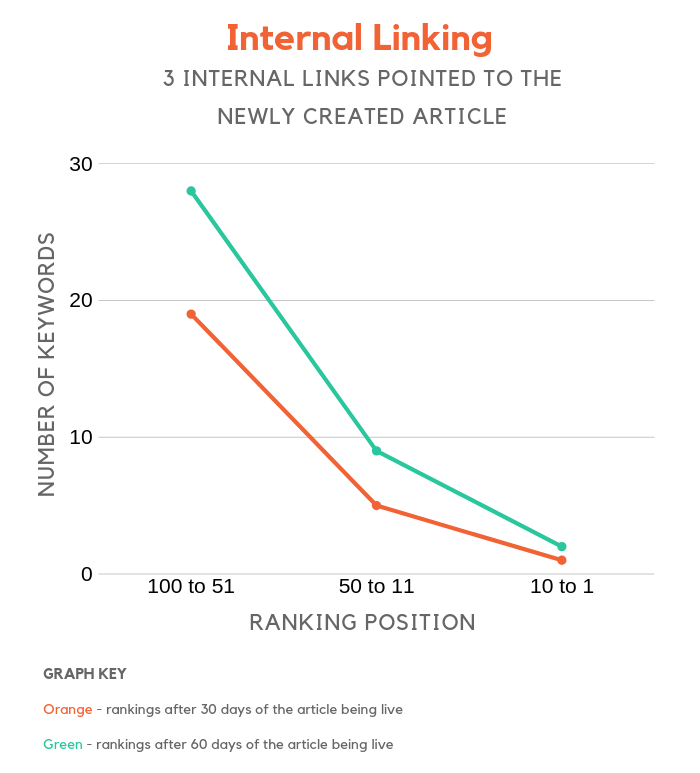
Articles that leveraged 3 internal links had more page 1 rankings than sites that just used an XML sitemap.
URL inspection group
If you aren’t familiar with the URL inspection feature within Google Search Console, it’s a quick way to getting your content index.
Just log into Search Console and type in your article URL in the search bar at the top. You’ll see a screen that looks something like this:
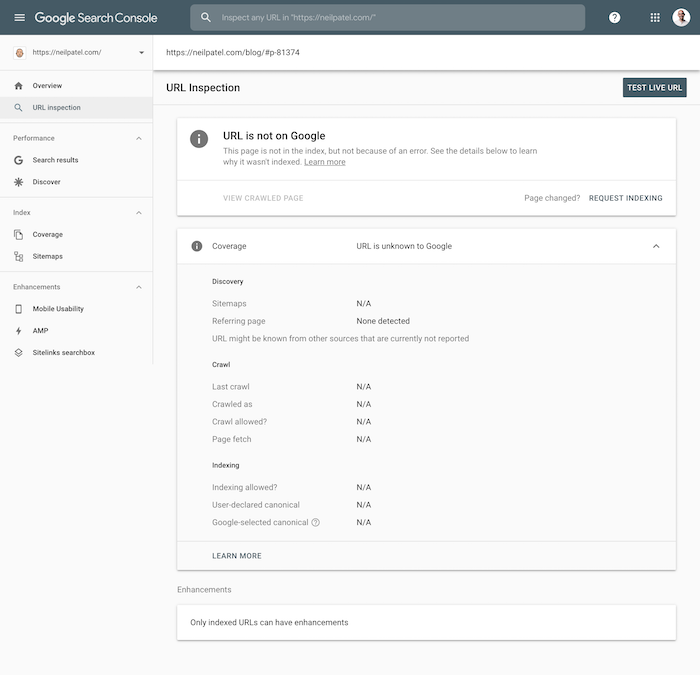
All you have to do is click the “request indexing” link.
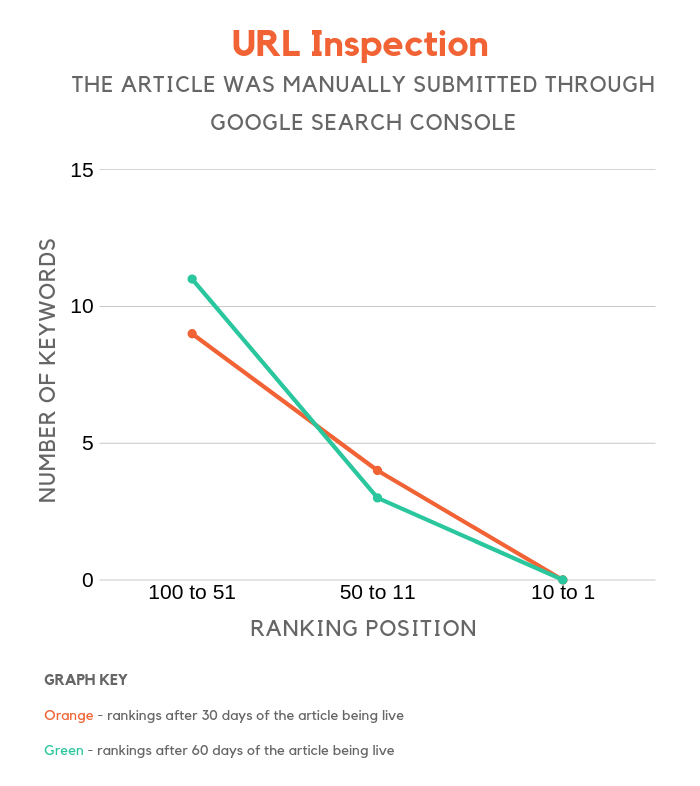
Leveraging this feature has a similar result to using the sitemap.
Social shares group
I’ve noticed a trend with my own website, in which if I create a piece of content that goes viral on the social web, my rankings for that new piece of content skyrocket to the top of Google… at least in the very short run.
And after a few weeks, I notice that my rankings drop.
Now, my site isn’t a large enough sample size and there are many reasons why my site ranks really well quickly.
Nonetheless, it was interesting to see how much social shares impact rankings.
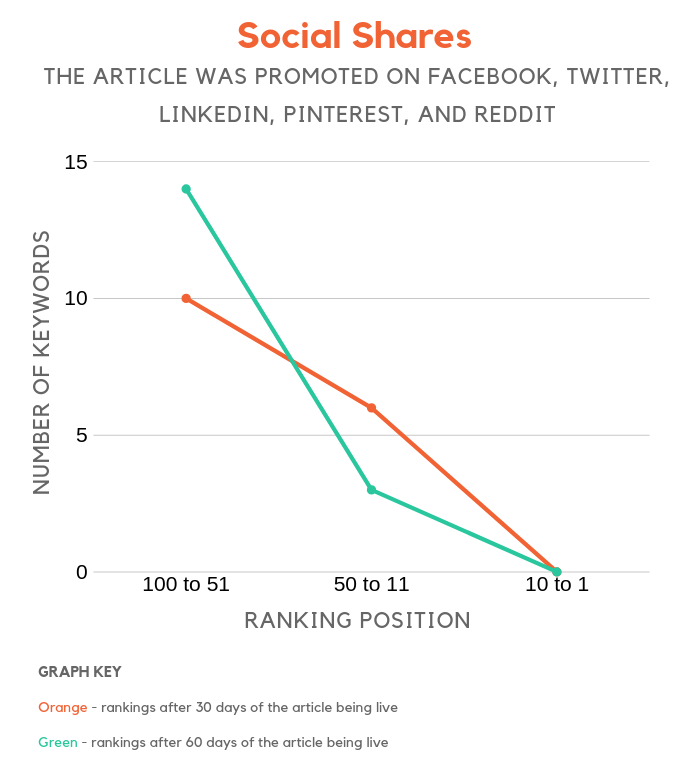
Getting social shares substantially performed better than the control group, but similar to my experience with NeilPatel.com, the rankings did slip a bit in month 2 instead of continually rising to the top.
Social shares may not have a direct impact on rankings, but the more people who see your content the higher the chance you build backlinks, increase your brand queries, and build brand loyalty.
Google Chrome lookup group
Do you know how people are saying that Google is using data from Google Analytics and Chrome to determine how high your site should rank?
Well, I wasn’t able to prove that from this experiment.
I had 40 random people directly type in the URL of each new article into Google Chrome. I spread it out over a week, making sure they clicked around on the site and stayed for at least 2 minutes.
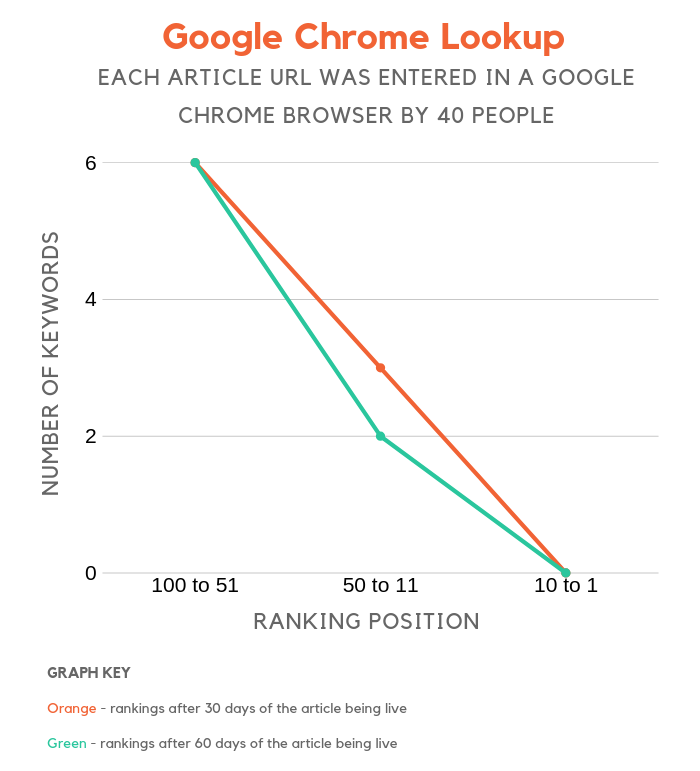
The ranking results were very similar to the control group.
Meta tags group
Now this group performed very similarly to the group that leveraged internal linking. And the month 2 results outperformed all other groups.
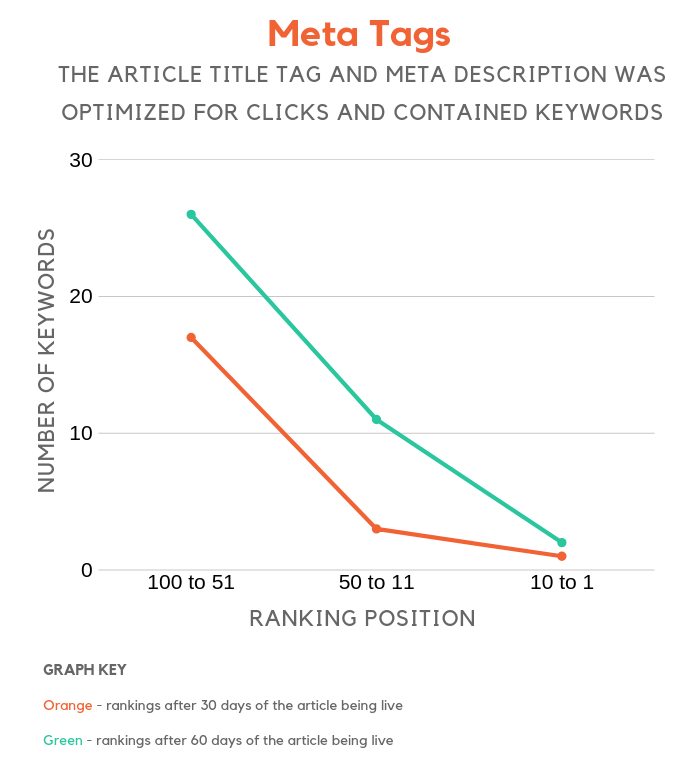
User metrics are a key part of Google’s algorithm. If you can create a compelling title tag and meta description, you’ll see a boost in your click-through rate and eventually, your rankings will climb.
If you want to boost your rankings through your meta tags, it’s not just about adding in the right keywords, you’ll also want to boost your click-through rate. Follow these steps to do just that.
URL group
The 8th group tested if URL length impacts how high a new piece of content ranks on Google.
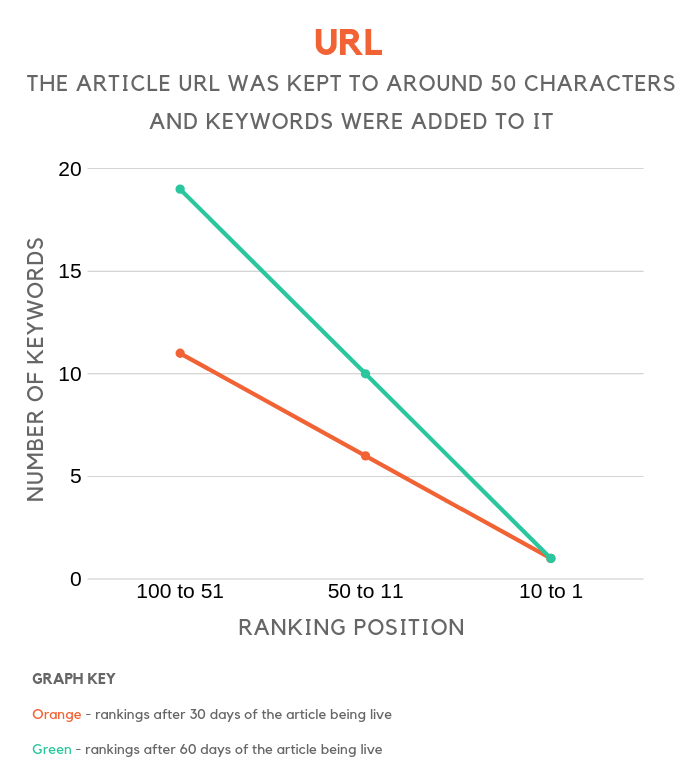
Based on the graph above, you can see that it does. It didn’t have as much of an impact as internal linking or meta tags, but it did have an impact.
The key to creating SEO friendly URLs is to include a keyword or two and keep them short.
If your URL is too long and descriptive, such as:
neilpatel.com/blog/how-to-optimize-your-meta-tags-for-search-engines
The article will rank for very long tail phrases but will struggle to rank for more popular terms like “meta tags” compared to URLs like:
neilpatel.com/blog/meta-tags/
The beautiful part about the short URLs is that they rank well for head terms and long tail phrases.
Conclusion
The charts clearly show that little things like meta tags, URLs, internal linking, social shares, and even sitemaps help.
But the key to doing well, especially if you want your new content to rank well is to not just do one of those things, but instead do them all.
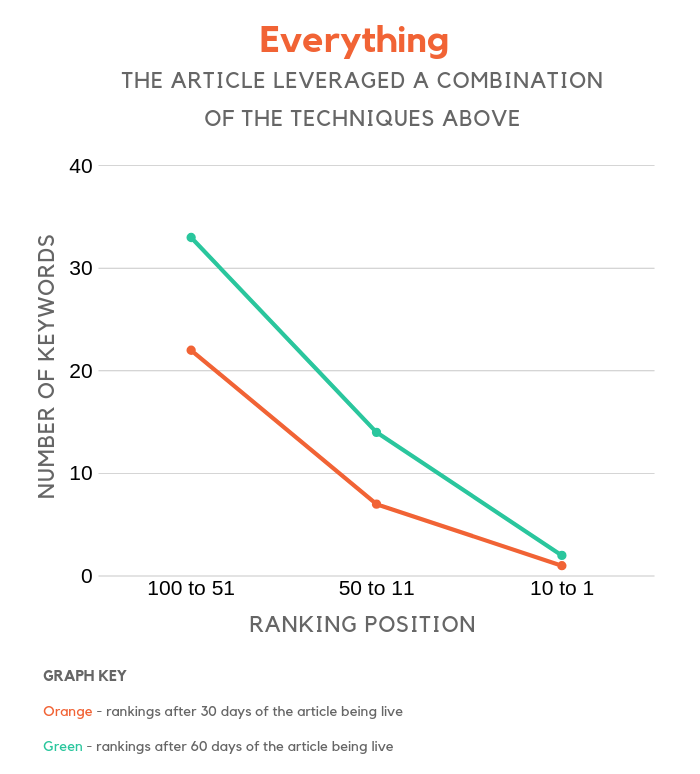
As you can see from the chart, doing everything gives you the best results. Now sure, some of the things are redundant like using an XML sitemap and using the URL inspection feature, but you get the point.
You’ll also notice that when you leverage everything together your results aren’t exponentially better… SEO is competitive and has turned into a game where every little thing adds up.
If you want to do well and have your new AND old content rank faster and higher, you need to do everything.
I know the tactics above aren’t anything revolutionary or new, but it’s interesting to look at the data and see how specific tactics affect rankings.
So, what do you think?


